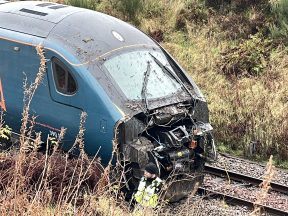Work to reinforce the beaver population in Argyll has successfully boosted their numbers in the area.
Scottish Beavers, a partnership between the Royal Zoological Society of Scotland (RZSS) and the Scottish Wildlife Trust, released 21 beavers into Knapdale Forest between 2017 and 2019 to bolster the population amid fears it might disappear.
Between May 2009 and June 2010, 16 beavers were released into the forest as part of the Scottish Beaver Trial which aimed to bring the species back to Scotland after 400 years.
However a survey in 2016 found a minimum of eight animals remained at the trial site and it was deemed there was a “very real chance” that Knapdale’s beaver population could disappear entirely.
But a new report says the reinforcement project has been a success, with the endangered species now more widespread and breeding throughout the area, while it has also increased the genetic diversity of Knapdale’s population.
The new beavers brought to Knapdale were primarily sourced from Tayside and originate from Bavaria, while the original Scottish Beaver Trial population was sourced from Norway.
Gill Dowse, knowledge and evidence manager at Scottish Wildlife Trust, said: “The Scottish Beaver Trial was a landmark conservation project that showed how beavers can create and restore important wetland and native woodland habitats.
“A limited number of beavers were introduced during the trial so it was important to go back and release more beavers, giving them a good chance to thrive.
“After three years of fieldwork we can be confident this reinforcement project has been a success, and that we have done all we can to bolster the wild population in Knapdale.
“Encouraging a thriving beaver population in Scotland is an important step towards tackling the crisis facing nature. Bringing them back helps a huge range of other species, from dragonflies to otters.
“There are also substantial benefits for society, ranging from improved water quality to new opportunities for wildlife tourism.”
During the reinforcement project, 17 adult beavers were released, two of which died. Four kits were also released, but three are confirmed dead and the whereabouts of the fourth is unknown.
The final report from the Scottish Beavers Reinforcement Project, published on Monday, contains a number of recommendations to secure a long-term future for the animals in Scotland.
These include developing a national conservation action plan for beavers, permitting reintroductions in other suitable areas of Scotland, and widening the “founder base” by introducing more animals from Europe.
It also recommends developing a genetic database of all beavers involved in translocations in the UK.
Helen Taylor, RZSS conservation programme manager, said: “Monitoring the beaver population in Knapdale for the past three years and tracking the fortunes of these newly-released animals has painted a clear picture of a steadily growing population that is beginning to spread out into all the various waterways available in Knapdale Forest.
“It’s been fantastic that the project provided an initial solution for moving beavers from high-conflict areas in Tayside into Knapdale, where their positive impacts on the environment and on native biodiversity are clear to see.”
Follow STV News on WhatsApp
Scan the QR code on your mobile device for all the latest news from around the country


























